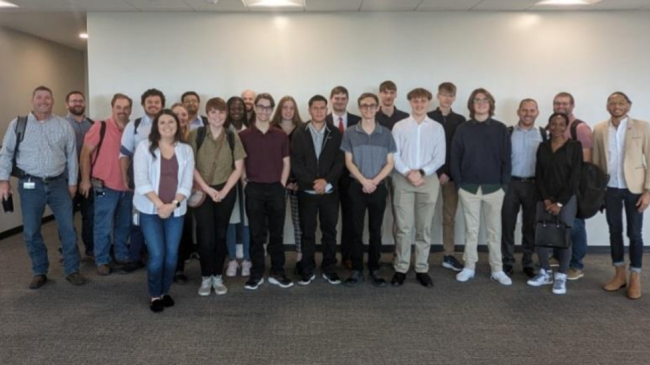You have /5 articles left.
Sign up for a free account or log in.

Students at the University of Omaha Nebraska’s College of Information Science and Technology attended a job shadow at the First National Bank of Omaha as part of the Learn and Earn program.
University of Nebraska at Omaha
To strengthen the local tech talent pipeline in the region, the University of Nebraska at Omaha’s College of Information Science and Technology created Learn and Earn, a multiyear workforce development program for undergraduate students.
Through Learn and Earn, students work alongside local partner companies to complete a job shadow, micro- and long-term internship, gaining insight into technology jobs in Nebraska and building connections to industry professionals.
What’s the need: Nebraska has faced a “brain drain” for the past decade—its college-educated population dips at higher rates than it grows from outmigration. Most who leave cite their career as a primary influence, as they look for higher wages or professional growth opportunities.
Yet several Fortune 500 companies are based in the state, explains Martha Garcia-Murillo, dean of the College of Information Science and Technology. “Not only that, we have several Fortune 1,000, and the students are not aware of them.”
Students can be attracted to seemingly higher wages in a different city, not realizing a higher cost of living will detract from their potential earnings, as well.
UNO also has a high population of students who work part-time in roles unrelated to their major, such as hospitality or retail.
“My main concern when I came to UNO is that our students were not getting the experience that they needed to be able to land that first job,” says Garcia-Murillo. “I recognize that for many of our students who worked it was too easy to maintain the job they had, because it’s already part of their routine, it’s paying the bills—‘If I look for an internship, it’s going to take time away from steady side work.’ It’s an inertia that pulls them into the job that they already have.”
To provide relevant work opportunities, UNO implemented Learn and Earn for all students in the College of Information Science and Technology, as well as to reveal job opportunities in the state prior to graduation.
How it works: Learn and Earn launched during the 2022–23 academic year and has four building blocks for each year.
Students complete three job shadows at UNO’s 30 partner organizations as part of their first-year seminar course. Job partners, including Fiserv, the Nebraska Library Commission and Aviture, introduce students to the entire IT team to expose them to a variety of roles in the tech sector.
“The companies ask us, ‘What are their majors?’ and I said, ‘Don’t worry about the majors; we want them to explore,’” Garcia-Murillo says.
The second year, students participate in microinternships for a partner organization. Students dedicate 10 to 40 hours with their host company to completing a small project such as data cleaning, researching cybersecurity threats or coding cleanup.
Right now, administrators are brainstorming ways to make the microinternship accessible for students but also not a heavy lift on partners. Technology roles often require a level of security clearance that could feel nonsensical for a 40-hour project, Garcia-Murillo explains. The current plan is to enroll students in a one-credit course that will take place over an academic term with visits from partner staff.
In their third and fourth years, students will participate in paid internships with job partners that last up to an academic year. Partner companies will post roles on UNO’s Handshake job board with the tag “Learn and Earn” to alert IS&T students that this is an opportunity for them.
“We’re trying to make it easy for them to find each other,” Garcia-Murillo says.
Interns will be paid an hourly rate set and paid by their employer that is above minimum wage, as well. Transfer students and graduate students can apply for internships shortly after entering the college, according to UNO’s website.
Measuring success: UNO leaders will gauge program effectiveness with a few metrics, Garcia-Murillo says.
First, staff will look at the conversion from part-time work into a yearlong internship and from relevant work experience into their first job after graduating. “I suspect that the more experience a student has, the more likely that they’re going to get a job right away after college,” Garcia-Murillo says.
Survey data will also measure student awareness of different tech roles and specifically students’ desired employers after graduation.
“I want to see how many converted from not knowing [Nebraska employers] and listing the traditional tech companies all over the country to [companies] in Nebraska, because that will be a measure of success,” she adds.
Scaling up: Learn and Earn will enter its second year this fall, but over the next five years university leaders hope the program doubles in size. Garcia-Murillo anticipates around 150 new IS&T students will enter this fall, but the program has grown 15 to 20 percent annually over the past few years.
UNO will continue to expand its partner offerings to meet the scale of students who will be in work-based learning roles.
If your student success program has a unique feature or twist, we’d like to know about it. Click here to submit.




